Human Resource Management Practices
VerifiedAdded on 2020/10/22
|12
|3628
|54
AI Summary
This assignment is focused on the topic of Human Resource Management (HRM) Practices. It includes a list of references to various books and journals that discuss HRM in different contexts, such as sport and recreation, public sector performance management, environmental performance, and more. The references are from reputable sources like Routledge, Kogan Page Publishers, and Palgrave. This assignment is likely intended for students studying HRM or related fields, and it provides a comprehensive overview of the subject matter. It covers topics like high-performance human resource practices, employee outcomes, public service motivation, compensation strategies, job demands-resources theory, service orientation, employee engagement, and perceived leadership style.
Contribute Materials
Your contribution can guide someone’s learning journey. Share your
documents today.
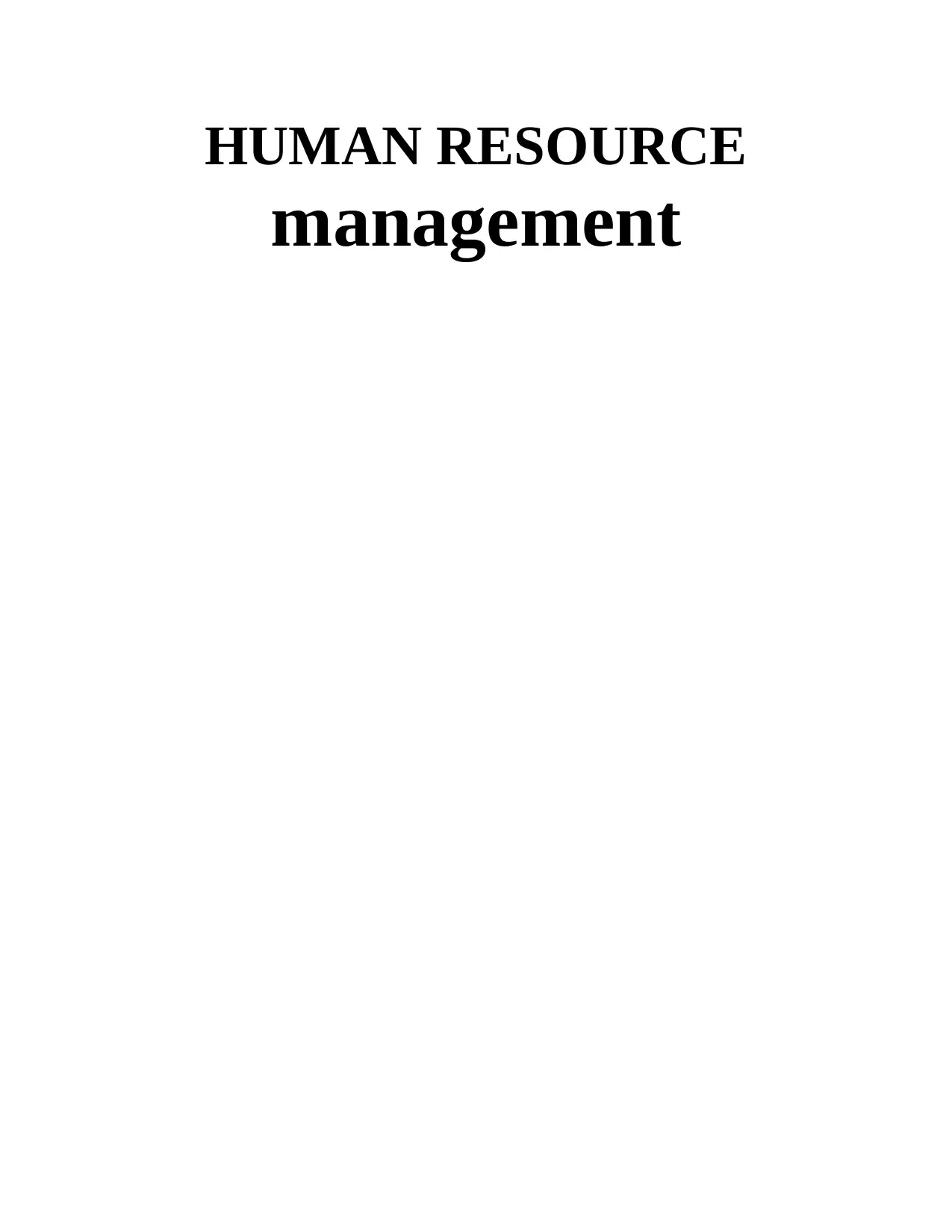
HUMAN RESOURCE
management
management
Secure Best Marks with AI Grader
Need help grading? Try our AI Grader for instant feedback on your assignments.
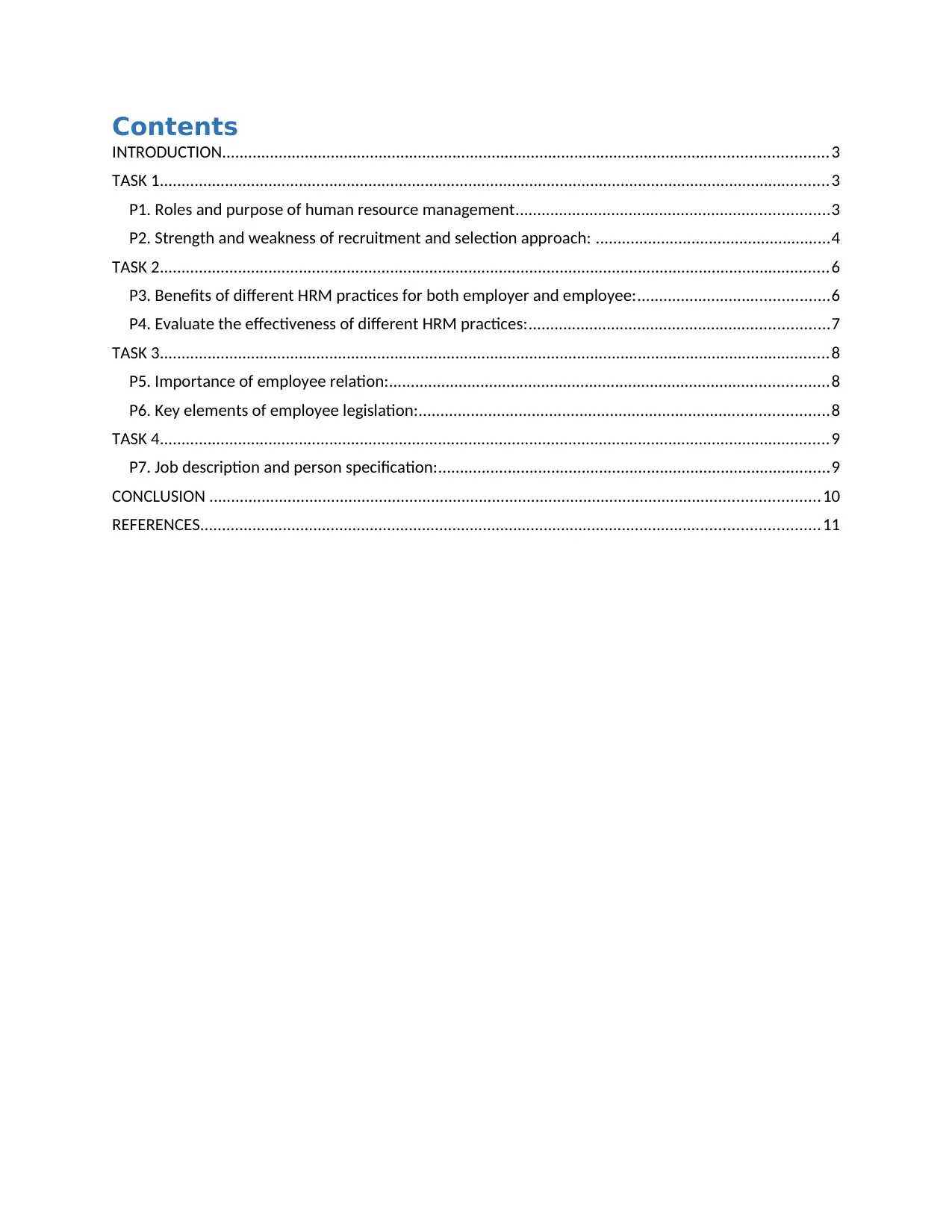
Contents
INTRODUCTION...........................................................................................................................................3
TASK 1..........................................................................................................................................................3
P1. Roles and purpose of human resource management........................................................................3
P2. Strength and weakness of recruitment and selection approach: ......................................................4
TASK 2..........................................................................................................................................................6
P3. Benefits of different HRM practices for both employer and employee:............................................6
P4. Evaluate the effectiveness of different HRM practices:.....................................................................7
TASK 3..........................................................................................................................................................8
P5. Importance of employee relation:.....................................................................................................8
P6. Key elements of employee legislation:..............................................................................................8
TASK 4..........................................................................................................................................................9
P7. Job description and person specification:..........................................................................................9
CONCLUSION ............................................................................................................................................10
REFERENCES..............................................................................................................................................11
INTRODUCTION...........................................................................................................................................3
TASK 1..........................................................................................................................................................3
P1. Roles and purpose of human resource management........................................................................3
P2. Strength and weakness of recruitment and selection approach: ......................................................4
TASK 2..........................................................................................................................................................6
P3. Benefits of different HRM practices for both employer and employee:............................................6
P4. Evaluate the effectiveness of different HRM practices:.....................................................................7
TASK 3..........................................................................................................................................................8
P5. Importance of employee relation:.....................................................................................................8
P6. Key elements of employee legislation:..............................................................................................8
TASK 4..........................................................................................................................................................9
P7. Job description and person specification:..........................................................................................9
CONCLUSION ............................................................................................................................................10
REFERENCES..............................................................................................................................................11
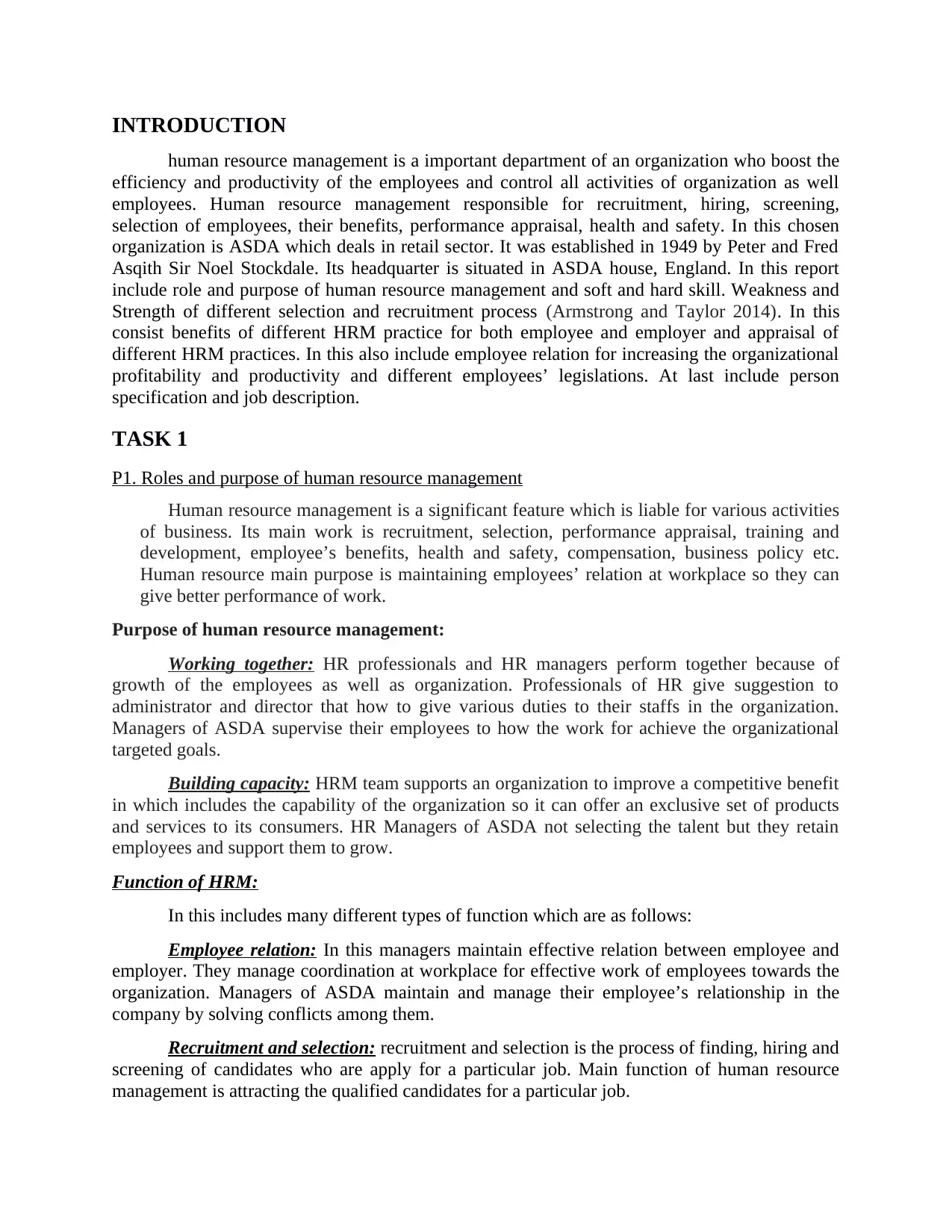
INTRODUCTION
human resource management is a important department of an organization who boost the
efficiency and productivity of the employees and control all activities of organization as well
employees. Human resource management responsible for recruitment, hiring, screening,
selection of employees, their benefits, performance appraisal, health and safety. In this chosen
organization is ASDA which deals in retail sector. It was established in 1949 by Peter and Fred
Asqith Sir Noel Stockdale. Its headquarter is situated in ASDA house, England. In this report
include role and purpose of human resource management and soft and hard skill. Weakness and
Strength of different selection and recruitment process (Armstrong and Taylor 2014). In this
consist benefits of different HRM practice for both employee and employer and appraisal of
different HRM practices. In this also include employee relation for increasing the organizational
profitability and productivity and different employees’ legislations. At last include person
specification and job description.
TASK 1
P1. Roles and purpose of human resource management
Human resource management is a significant feature which is liable for various activities
of business. Its main work is recruitment, selection, performance appraisal, training and
development, employee’s benefits, health and safety, compensation, business policy etc.
Human resource main purpose is maintaining employees’ relation at workplace so they can
give better performance of work.
Purpose of human resource management:
Working together: HR professionals and HR managers perform together because of
growth of the employees as well as organization. Professionals of HR give suggestion to
administrator and director that how to give various duties to their staffs in the organization.
Managers of ASDA supervise their employees to how the work for achieve the organizational
targeted goals.
Building capacity: HRM team supports an organization to improve a competitive benefit
in which includes the capability of the organization so it can offer an exclusive set of products
and services to its consumers. HR Managers of ASDA not selecting the talent but they retain
employees and support them to grow.
Function of HRM:
In this includes many different types of function which are as follows:
Employee relation: In this managers maintain effective relation between employee and
employer. They manage coordination at workplace for effective work of employees towards the
organization. Managers of ASDA maintain and manage their employee’s relationship in the
company by solving conflicts among them.
Recruitment and selection: recruitment and selection is the process of finding, hiring and
screening of candidates who are apply for a particular job. Main function of human resource
management is attracting the qualified candidates for a particular job.
human resource management is a important department of an organization who boost the
efficiency and productivity of the employees and control all activities of organization as well
employees. Human resource management responsible for recruitment, hiring, screening,
selection of employees, their benefits, performance appraisal, health and safety. In this chosen
organization is ASDA which deals in retail sector. It was established in 1949 by Peter and Fred
Asqith Sir Noel Stockdale. Its headquarter is situated in ASDA house, England. In this report
include role and purpose of human resource management and soft and hard skill. Weakness and
Strength of different selection and recruitment process (Armstrong and Taylor 2014). In this
consist benefits of different HRM practice for both employee and employer and appraisal of
different HRM practices. In this also include employee relation for increasing the organizational
profitability and productivity and different employees’ legislations. At last include person
specification and job description.
TASK 1
P1. Roles and purpose of human resource management
Human resource management is a significant feature which is liable for various activities
of business. Its main work is recruitment, selection, performance appraisal, training and
development, employee’s benefits, health and safety, compensation, business policy etc.
Human resource main purpose is maintaining employees’ relation at workplace so they can
give better performance of work.
Purpose of human resource management:
Working together: HR professionals and HR managers perform together because of
growth of the employees as well as organization. Professionals of HR give suggestion to
administrator and director that how to give various duties to their staffs in the organization.
Managers of ASDA supervise their employees to how the work for achieve the organizational
targeted goals.
Building capacity: HRM team supports an organization to improve a competitive benefit
in which includes the capability of the organization so it can offer an exclusive set of products
and services to its consumers. HR Managers of ASDA not selecting the talent but they retain
employees and support them to grow.
Function of HRM:
In this includes many different types of function which are as follows:
Employee relation: In this managers maintain effective relation between employee and
employer. They manage coordination at workplace for effective work of employees towards the
organization. Managers of ASDA maintain and manage their employee’s relationship in the
company by solving conflicts among them.
Recruitment and selection: recruitment and selection is the process of finding, hiring and
screening of candidates who are apply for a particular job. Main function of human resource
management is attracting the qualified candidates for a particular job.
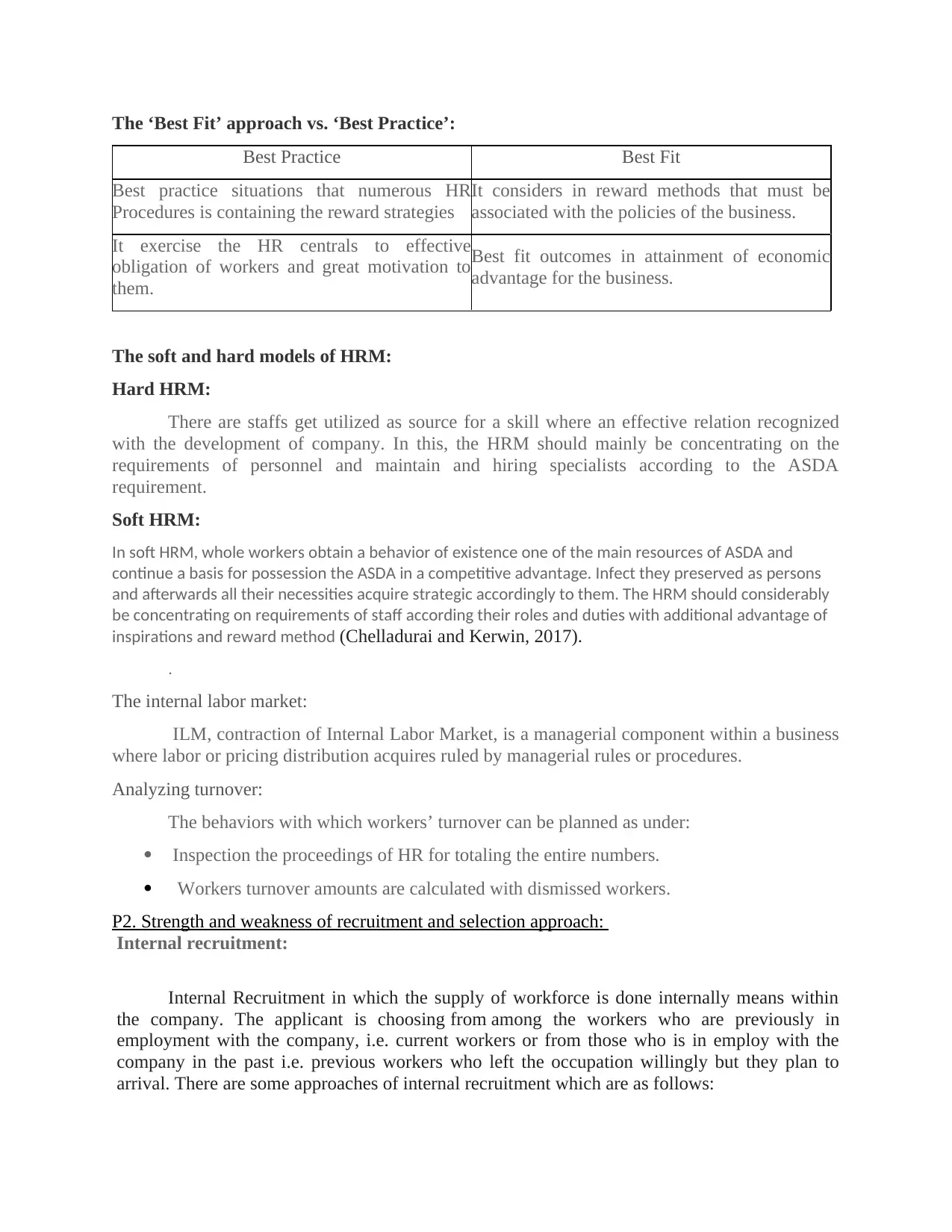
The ‘Best Fit’ approach vs. ‘Best Practice’:
Best Practice Best Fit
Best practice situations that numerous HR
Procedures is containing the reward strategies
It considers in reward methods that must be
associated with the policies of the business.
It exercise the HR centrals to effective
obligation of workers and great motivation to
them.
Best fit outcomes in attainment of economic
advantage for the business.
The soft and hard models of HRM:
Hard HRM:
There are staffs get utilized as source for a skill where an effective relation recognized
with the development of company. In this, the HRM should mainly be concentrating on the
requirements of personnel and maintain and hiring specialists according to the ASDA
requirement.
Soft HRM:
In soft HRM, whole workers obtain a behavior of existence one of the main resources of ASDA and
continue a basis for possession the ASDA in a competitive advantage. Infect they preserved as persons
and afterwards all their necessities acquire strategic accordingly to them. The HRM should considerably
be concentrating on requirements of staff according their roles and duties with additional advantage of
inspirations and reward method (Chelladurai and Kerwin, 2017).
.
The internal labor market:
ILM, contraction of Internal Labor Market, is a managerial component within a business
where labor or pricing distribution acquires ruled by managerial rules or procedures.
Analyzing turnover:
The behaviors with which workers’ turnover can be planned as under:
Inspection the proceedings of HR for totaling the entire numbers.
Workers turnover amounts are calculated with dismissed workers.
P2. Strength and weakness of recruitment and selection approach:
Internal recruitment:
Internal Recruitment in which the supply of workforce is done internally means within
the company. The applicant is choosing from among the workers who are previously in
employment with the company, i.e. current workers or from those who is in employ with the
company in the past i.e. previous workers who left the occupation willingly but they plan to
arrival. There are some approaches of internal recruitment which are as follows:
Best Practice Best Fit
Best practice situations that numerous HR
Procedures is containing the reward strategies
It considers in reward methods that must be
associated with the policies of the business.
It exercise the HR centrals to effective
obligation of workers and great motivation to
them.
Best fit outcomes in attainment of economic
advantage for the business.
The soft and hard models of HRM:
Hard HRM:
There are staffs get utilized as source for a skill where an effective relation recognized
with the development of company. In this, the HRM should mainly be concentrating on the
requirements of personnel and maintain and hiring specialists according to the ASDA
requirement.
Soft HRM:
In soft HRM, whole workers obtain a behavior of existence one of the main resources of ASDA and
continue a basis for possession the ASDA in a competitive advantage. Infect they preserved as persons
and afterwards all their necessities acquire strategic accordingly to them. The HRM should considerably
be concentrating on requirements of staff according their roles and duties with additional advantage of
inspirations and reward method (Chelladurai and Kerwin, 2017).
.
The internal labor market:
ILM, contraction of Internal Labor Market, is a managerial component within a business
where labor or pricing distribution acquires ruled by managerial rules or procedures.
Analyzing turnover:
The behaviors with which workers’ turnover can be planned as under:
Inspection the proceedings of HR for totaling the entire numbers.
Workers turnover amounts are calculated with dismissed workers.
P2. Strength and weakness of recruitment and selection approach:
Internal recruitment:
Internal Recruitment in which the supply of workforce is done internally means within
the company. The applicant is choosing from among the workers who are previously in
employment with the company, i.e. current workers or from those who is in employ with the
company in the past i.e. previous workers who left the occupation willingly but they plan to
arrival. There are some approaches of internal recruitment which are as follows:
Secure Best Marks with AI Grader
Need help grading? Try our AI Grader for instant feedback on your assignments.
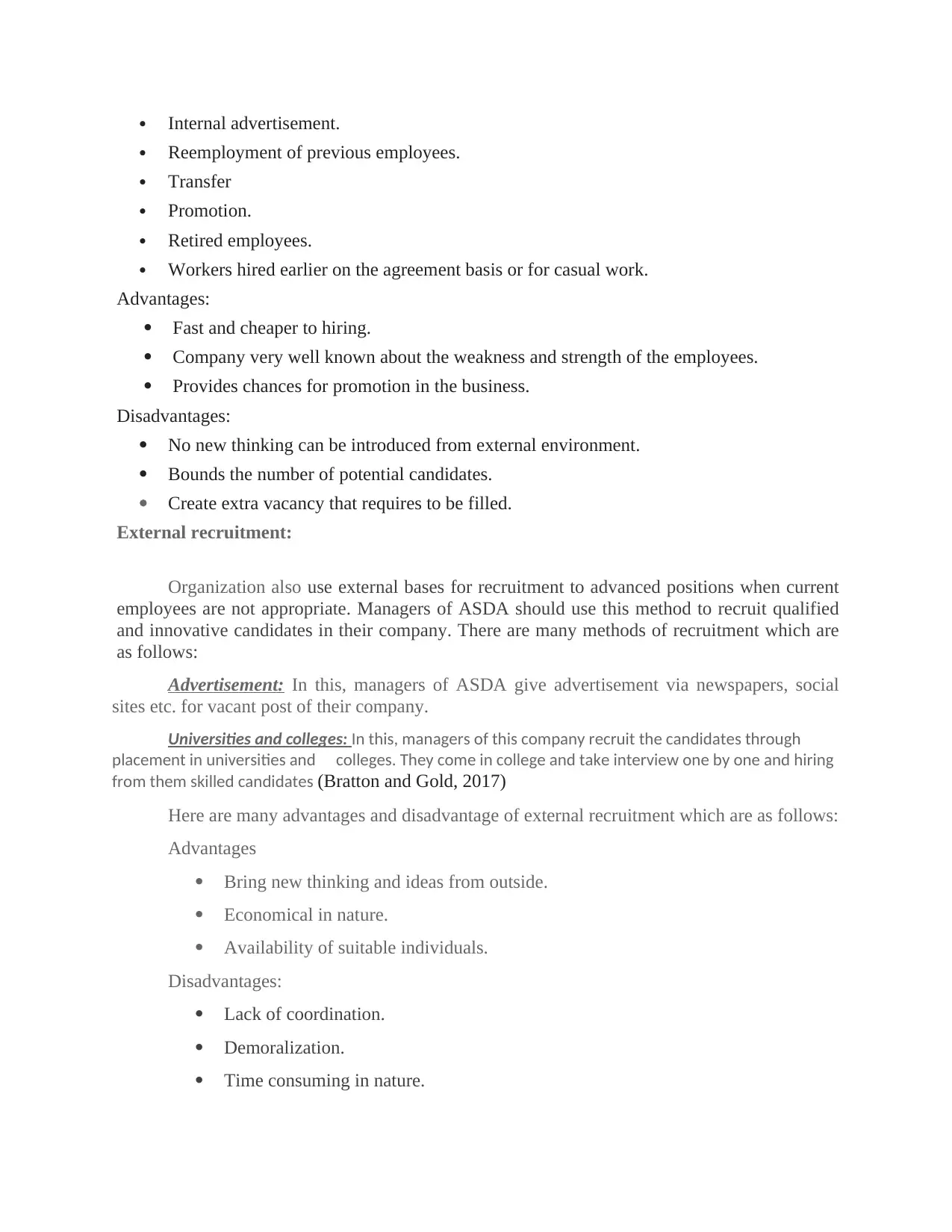
Internal advertisement.
Reemployment of previous employees.
Transfer
Promotion.
Retired employees.
Workers hired earlier on the agreement basis or for casual work.
Advantages:
Fast and cheaper to hiring.
Company very well known about the weakness and strength of the employees.
Provides chances for promotion in the business.
Disadvantages:
No new thinking can be introduced from external environment.
Bounds the number of potential candidates.
Create extra vacancy that requires to be filled.
External recruitment:
Organization also use external bases for recruitment to advanced positions when current
employees are not appropriate. Managers of ASDA should use this method to recruit qualified
and innovative candidates in their company. There are many methods of recruitment which are
as follows:
Advertisement: In this, managers of ASDA give advertisement via newspapers, social
sites etc. for vacant post of their company.
Universities and colleges: In this, managers of this company recruit the candidates through
placement in universities and colleges. They come in college and take interview one by one and hiring
from them skilled candidates (Bratton and Gold, 2017)
Here are many advantages and disadvantage of external recruitment which are as follows:
Advantages
Bring new thinking and ideas from outside.
Economical in nature.
Availability of suitable individuals.
Disadvantages:
Lack of coordination.
Demoralization.
Time consuming in nature.
Reemployment of previous employees.
Transfer
Promotion.
Retired employees.
Workers hired earlier on the agreement basis or for casual work.
Advantages:
Fast and cheaper to hiring.
Company very well known about the weakness and strength of the employees.
Provides chances for promotion in the business.
Disadvantages:
No new thinking can be introduced from external environment.
Bounds the number of potential candidates.
Create extra vacancy that requires to be filled.
External recruitment:
Organization also use external bases for recruitment to advanced positions when current
employees are not appropriate. Managers of ASDA should use this method to recruit qualified
and innovative candidates in their company. There are many methods of recruitment which are
as follows:
Advertisement: In this, managers of ASDA give advertisement via newspapers, social
sites etc. for vacant post of their company.
Universities and colleges: In this, managers of this company recruit the candidates through
placement in universities and colleges. They come in college and take interview one by one and hiring
from them skilled candidates (Bratton and Gold, 2017)
Here are many advantages and disadvantage of external recruitment which are as follows:
Advantages
Bring new thinking and ideas from outside.
Economical in nature.
Availability of suitable individuals.
Disadvantages:
Lack of coordination.
Demoralization.
Time consuming in nature.
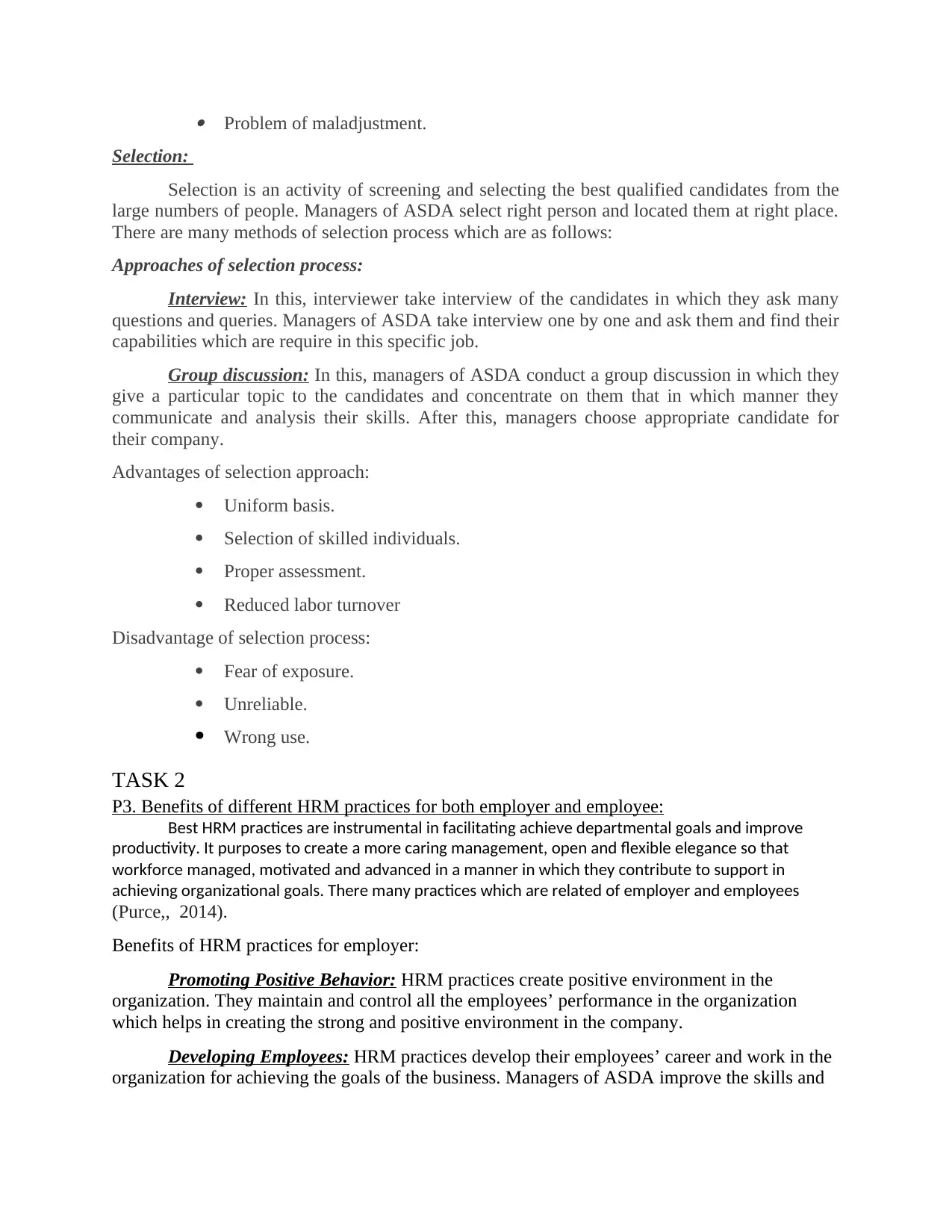
Problem of maladjustment.
Selection:
Selection is an activity of screening and selecting the best qualified candidates from the
large numbers of people. Managers of ASDA select right person and located them at right place.
There are many methods of selection process which are as follows:
Approaches of selection process:
Interview: In this, interviewer take interview of the candidates in which they ask many
questions and queries. Managers of ASDA take interview one by one and ask them and find their
capabilities which are require in this specific job.
Group discussion: In this, managers of ASDA conduct a group discussion in which they
give a particular topic to the candidates and concentrate on them that in which manner they
communicate and analysis their skills. After this, managers choose appropriate candidate for
their company.
Advantages of selection approach:
Uniform basis.
Selection of skilled individuals.
Proper assessment.
Reduced labor turnover
Disadvantage of selection process:
Fear of exposure.
Unreliable.
Wrong use.
TASK 2
P3. Benefits of different HRM practices for both employer and employee:
Best HRM practices are instrumental in facilitating achieve departmental goals and improve
productivity. It purposes to create a more caring management, open and flexible elegance so that
workforce managed, motivated and advanced in a manner in which they contribute to support in
achieving organizational goals. There many practices which are related of employer and employees
(Purce,, 2014).
Benefits of HRM practices for employer:
Promoting Positive Behavior: HRM practices create positive environment in the
organization. They maintain and control all the employees’ performance in the organization
which helps in creating the strong and positive environment in the company.
Developing Employees: HRM practices develop their employees’ career and work in the
organization for achieving the goals of the business. Managers of ASDA improve the skills and
Selection:
Selection is an activity of screening and selecting the best qualified candidates from the
large numbers of people. Managers of ASDA select right person and located them at right place.
There are many methods of selection process which are as follows:
Approaches of selection process:
Interview: In this, interviewer take interview of the candidates in which they ask many
questions and queries. Managers of ASDA take interview one by one and ask them and find their
capabilities which are require in this specific job.
Group discussion: In this, managers of ASDA conduct a group discussion in which they
give a particular topic to the candidates and concentrate on them that in which manner they
communicate and analysis their skills. After this, managers choose appropriate candidate for
their company.
Advantages of selection approach:
Uniform basis.
Selection of skilled individuals.
Proper assessment.
Reduced labor turnover
Disadvantage of selection process:
Fear of exposure.
Unreliable.
Wrong use.
TASK 2
P3. Benefits of different HRM practices for both employer and employee:
Best HRM practices are instrumental in facilitating achieve departmental goals and improve
productivity. It purposes to create a more caring management, open and flexible elegance so that
workforce managed, motivated and advanced in a manner in which they contribute to support in
achieving organizational goals. There many practices which are related of employer and employees
(Purce,, 2014).
Benefits of HRM practices for employer:
Promoting Positive Behavior: HRM practices create positive environment in the
organization. They maintain and control all the employees’ performance in the organization
which helps in creating the strong and positive environment in the company.
Developing Employees: HRM practices develop their employees’ career and work in the
organization for achieving the goals of the business. Managers of ASDA improve the skills and
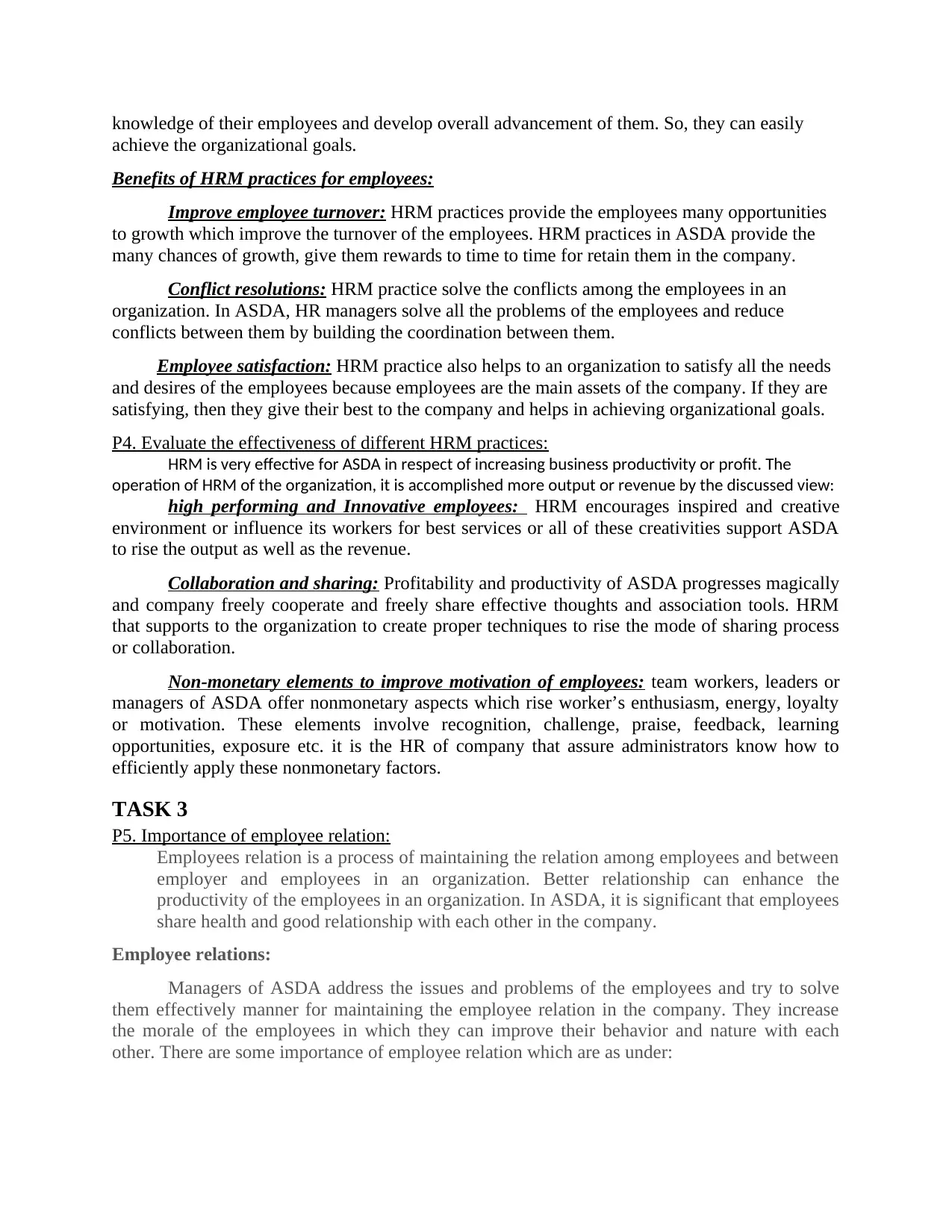
knowledge of their employees and develop overall advancement of them. So, they can easily
achieve the organizational goals.
Benefits of HRM practices for employees:
Improve employee turnover: HRM practices provide the employees many opportunities
to growth which improve the turnover of the employees. HRM practices in ASDA provide the
many chances of growth, give them rewards to time to time for retain them in the company.
Conflict resolutions: HRM practice solve the conflicts among the employees in an
organization. In ASDA, HR managers solve all the problems of the employees and reduce
conflicts between them by building the coordination between them.
Employee satisfaction: HRM practice also helps to an organization to satisfy all the needs
and desires of the employees because employees are the main assets of the company. If they are
satisfying, then they give their best to the company and helps in achieving organizational goals.
P4. Evaluate the effectiveness of different HRM practices:
HRM is very effective for ASDA in respect of increasing business productivity or profit. The
operation of HRM of the organization, it is accomplished more output or revenue by the discussed view:
high performing and Innovative employees: HRM encourages inspired and creative
environment or influence its workers for best services or all of these creativities support ASDA
to rise the output as well as the revenue.
Collaboration and sharing: Profitability and productivity of ASDA progresses magically
and company freely cooperate and freely share effective thoughts and association tools. HRM
that supports to the organization to create proper techniques to rise the mode of sharing process
or collaboration.
Non-monetary elements to improve motivation of employees: team workers, leaders or
managers of ASDA offer nonmonetary aspects which rise worker’s enthusiasm, energy, loyalty
or motivation. These elements involve recognition, challenge, praise, feedback, learning
opportunities, exposure etc. it is the HR of company that assure administrators know how to
efficiently apply these nonmonetary factors.
TASK 3
P5. Importance of employee relation:
Employees relation is a process of maintaining the relation among employees and between
employer and employees in an organization. Better relationship can enhance the
productivity of the employees in an organization. In ASDA, it is significant that employees
share health and good relationship with each other in the company.
Employee relations:
Managers of ASDA address the issues and problems of the employees and try to solve
them effectively manner for maintaining the employee relation in the company. They increase
the morale of the employees in which they can improve their behavior and nature with each
other. There are some importance of employee relation which are as under:
achieve the organizational goals.
Benefits of HRM practices for employees:
Improve employee turnover: HRM practices provide the employees many opportunities
to growth which improve the turnover of the employees. HRM practices in ASDA provide the
many chances of growth, give them rewards to time to time for retain them in the company.
Conflict resolutions: HRM practice solve the conflicts among the employees in an
organization. In ASDA, HR managers solve all the problems of the employees and reduce
conflicts between them by building the coordination between them.
Employee satisfaction: HRM practice also helps to an organization to satisfy all the needs
and desires of the employees because employees are the main assets of the company. If they are
satisfying, then they give their best to the company and helps in achieving organizational goals.
P4. Evaluate the effectiveness of different HRM practices:
HRM is very effective for ASDA in respect of increasing business productivity or profit. The
operation of HRM of the organization, it is accomplished more output or revenue by the discussed view:
high performing and Innovative employees: HRM encourages inspired and creative
environment or influence its workers for best services or all of these creativities support ASDA
to rise the output as well as the revenue.
Collaboration and sharing: Profitability and productivity of ASDA progresses magically
and company freely cooperate and freely share effective thoughts and association tools. HRM
that supports to the organization to create proper techniques to rise the mode of sharing process
or collaboration.
Non-monetary elements to improve motivation of employees: team workers, leaders or
managers of ASDA offer nonmonetary aspects which rise worker’s enthusiasm, energy, loyalty
or motivation. These elements involve recognition, challenge, praise, feedback, learning
opportunities, exposure etc. it is the HR of company that assure administrators know how to
efficiently apply these nonmonetary factors.
TASK 3
P5. Importance of employee relation:
Employees relation is a process of maintaining the relation among employees and between
employer and employees in an organization. Better relationship can enhance the
productivity of the employees in an organization. In ASDA, it is significant that employees
share health and good relationship with each other in the company.
Employee relations:
Managers of ASDA address the issues and problems of the employees and try to solve
them effectively manner for maintaining the employee relation in the company. They increase
the morale of the employees in which they can improve their behavior and nature with each
other. There are some importance of employee relation which are as under:
Paraphrase This Document
Need a fresh take? Get an instant paraphrase of this document with our AI Paraphraser
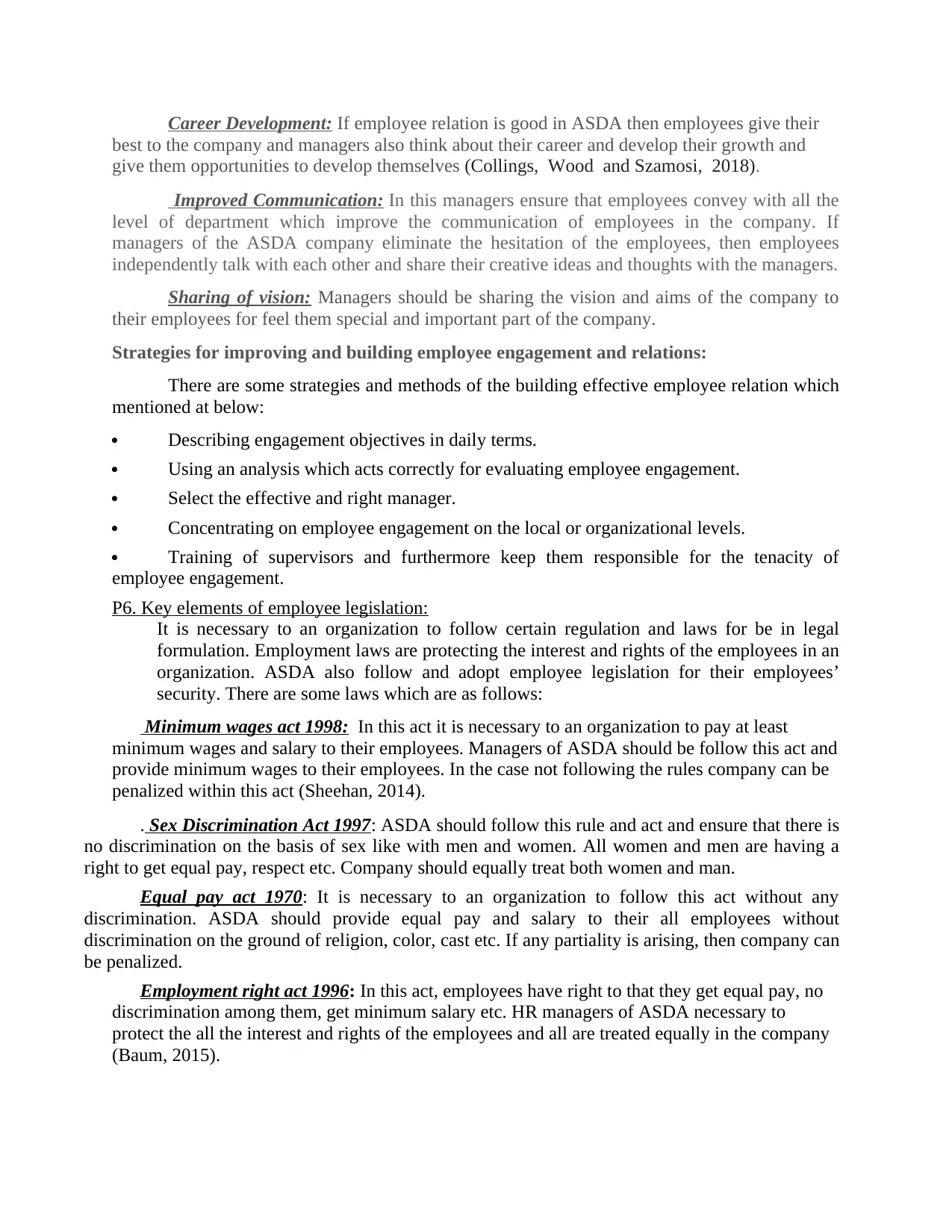
Career Development: If employee relation is good in ASDA then employees give their
best to the company and managers also think about their career and develop their growth and
give them opportunities to develop themselves (Collings, Wood and Szamosi, 2018).
Improved Communication: In this managers ensure that employees convey with all the
level of department which improve the communication of employees in the company. If
managers of the ASDA company eliminate the hesitation of the employees, then employees
independently talk with each other and share their creative ideas and thoughts with the managers.
Sharing of vision: Managers should be sharing the vision and aims of the company to
their employees for feel them special and important part of the company.
Strategies for improving and building employee engagement and relations:
There are some strategies and methods of the building effective employee relation which
mentioned at below:
Describing engagement objectives in daily terms.
Using an analysis which acts correctly for evaluating employee engagement.
Select the effective and right manager.
Concentrating on employee engagement on the local or organizational levels.
Training of supervisors and furthermore keep them responsible for the tenacity of
employee engagement.
P6. Key elements of employee legislation:
It is necessary to an organization to follow certain regulation and laws for be in legal
formulation. Employment laws are protecting the interest and rights of the employees in an
organization. ASDA also follow and adopt employee legislation for their employees’
security. There are some laws which are as follows:
Minimum wages act 1998: In this act it is necessary to an organization to pay at least
minimum wages and salary to their employees. Managers of ASDA should be follow this act and
provide minimum wages to their employees. In the case not following the rules company can be
penalized within this act (Sheehan, 2014).
. Sex Discrimination Act 1997: ASDA should follow this rule and act and ensure that there is
no discrimination on the basis of sex like with men and women. All women and men are having a
right to get equal pay, respect etc. Company should equally treat both women and man.
Equal pay act 1970: It is necessary to an organization to follow this act without any
discrimination. ASDA should provide equal pay and salary to their all employees without
discrimination on the ground of religion, color, cast etc. If any partiality is arising, then company can
be penalized.
Employment right act 1996: In this act, employees have right to that they get equal pay, no
discrimination among them, get minimum salary etc. HR managers of ASDA necessary to
protect the all the interest and rights of the employees and all are treated equally in the company
(Baum, 2015).
best to the company and managers also think about their career and develop their growth and
give them opportunities to develop themselves (Collings, Wood and Szamosi, 2018).
Improved Communication: In this managers ensure that employees convey with all the
level of department which improve the communication of employees in the company. If
managers of the ASDA company eliminate the hesitation of the employees, then employees
independently talk with each other and share their creative ideas and thoughts with the managers.
Sharing of vision: Managers should be sharing the vision and aims of the company to
their employees for feel them special and important part of the company.
Strategies for improving and building employee engagement and relations:
There are some strategies and methods of the building effective employee relation which
mentioned at below:
Describing engagement objectives in daily terms.
Using an analysis which acts correctly for evaluating employee engagement.
Select the effective and right manager.
Concentrating on employee engagement on the local or organizational levels.
Training of supervisors and furthermore keep them responsible for the tenacity of
employee engagement.
P6. Key elements of employee legislation:
It is necessary to an organization to follow certain regulation and laws for be in legal
formulation. Employment laws are protecting the interest and rights of the employees in an
organization. ASDA also follow and adopt employee legislation for their employees’
security. There are some laws which are as follows:
Minimum wages act 1998: In this act it is necessary to an organization to pay at least
minimum wages and salary to their employees. Managers of ASDA should be follow this act and
provide minimum wages to their employees. In the case not following the rules company can be
penalized within this act (Sheehan, 2014).
. Sex Discrimination Act 1997: ASDA should follow this rule and act and ensure that there is
no discrimination on the basis of sex like with men and women. All women and men are having a
right to get equal pay, respect etc. Company should equally treat both women and man.
Equal pay act 1970: It is necessary to an organization to follow this act without any
discrimination. ASDA should provide equal pay and salary to their all employees without
discrimination on the ground of religion, color, cast etc. If any partiality is arising, then company can
be penalized.
Employment right act 1996: In this act, employees have right to that they get equal pay, no
discrimination among them, get minimum salary etc. HR managers of ASDA necessary to
protect the all the interest and rights of the employees and all are treated equally in the company
(Baum, 2015).
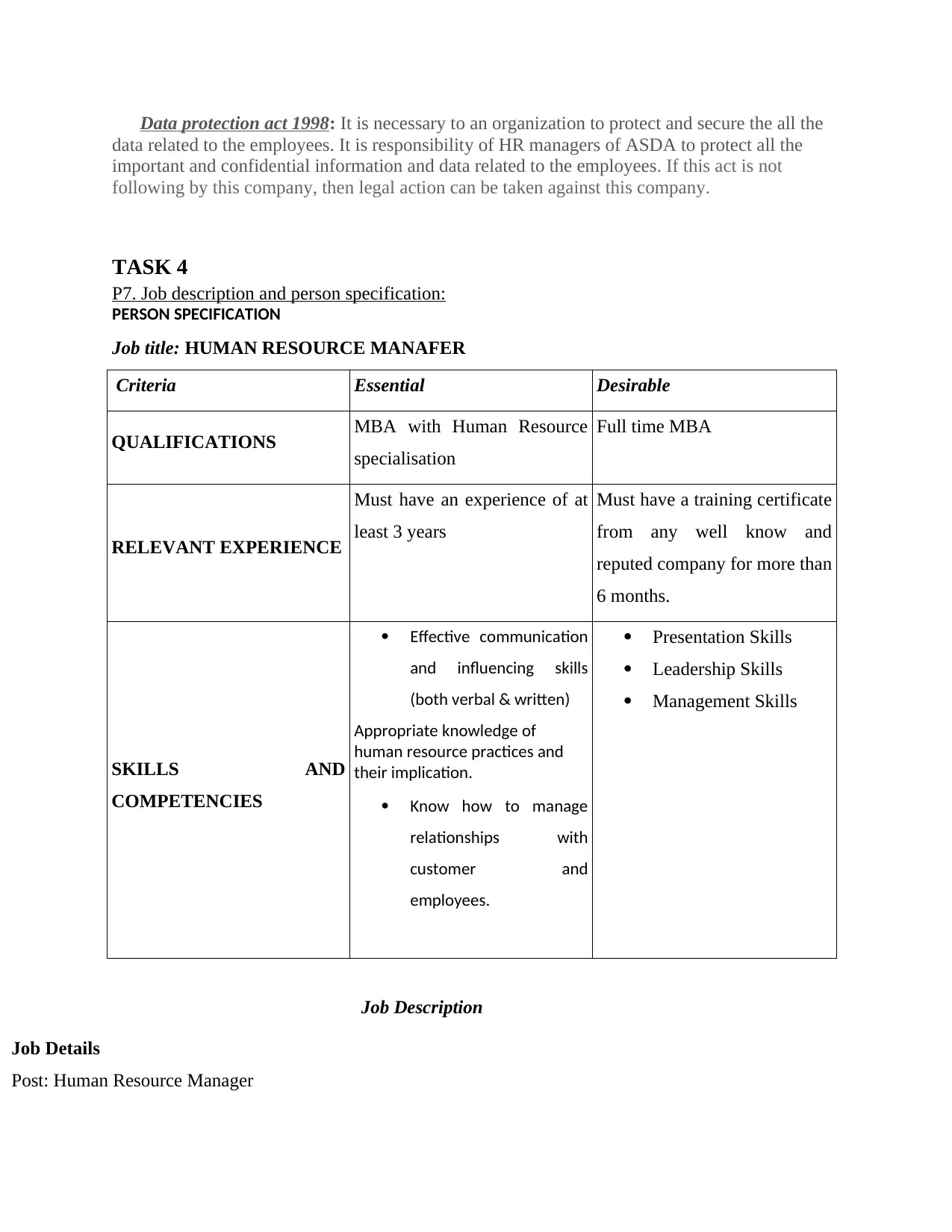
Data protection act 1998: It is necessary to an organization to protect and secure the all the
data related to the employees. It is responsibility of HR managers of ASDA to protect all the
important and confidential information and data related to the employees. If this act is not
following by this company, then legal action can be taken against this company.
TASK 4
P7. Job description and person specification:
PERSON SPECIFICATION
Job title: HUMAN RESOURCE MANAFER
Criteria Essential Desirable
QUALIFICATIONS MBA with Human Resource
specialisation
Full time MBA
RELEVANT EXPERIENCE
Must have an experience of at
least 3 years
Must have a training certificate
from any well know and
reputed company for more than
6 months.
SKILLS AND
COMPETENCIES
Effective communication
and influencing skills
(both verbal & written)
Appropriate knowledge of
human resource practices and
their implication.
Know how to manage
relationships with
customer and
employees.
Presentation Skills
Leadership Skills
Management Skills
Job Description
Job Details
Post: Human Resource Manager
data related to the employees. It is responsibility of HR managers of ASDA to protect all the
important and confidential information and data related to the employees. If this act is not
following by this company, then legal action can be taken against this company.
TASK 4
P7. Job description and person specification:
PERSON SPECIFICATION
Job title: HUMAN RESOURCE MANAFER
Criteria Essential Desirable
QUALIFICATIONS MBA with Human Resource
specialisation
Full time MBA
RELEVANT EXPERIENCE
Must have an experience of at
least 3 years
Must have a training certificate
from any well know and
reputed company for more than
6 months.
SKILLS AND
COMPETENCIES
Effective communication
and influencing skills
(both verbal & written)
Appropriate knowledge of
human resource practices and
their implication.
Know how to manage
relationships with
customer and
employees.
Presentation Skills
Leadership Skills
Management Skills
Job Description
Job Details
Post: Human Resource Manager

Department:
Job Summary
Understanding resource availability by analyzing net worth and cash flow of company.
Report financial status by forecasting and making report over financial information.
Management of employees by compensating on time and ensuring operations must be performing as per schedule
(Paillé and et. al., 2014).
All the law and regulations must be implemented effectively.
Roles & Responsibilities
Collecting and interpreting available information for creating report, budget, commercial and
financial information.
Responsible for formulating strategical plan.
Responsible for preparation of long-term business plan.
Control the expense and cash flow.
Developing and managing financial models.
Manage conflicts of employees during their operations.
Supervising the staff members over their work.
CONCLUSION
From the above given report, it has been summarized that human resource management is a main department
of an organization who improve the productivity and efficiency of the employees and control all the activities
of organization as well employees. They conduct main roles and purpose and build the effectiveness and
performance of the employees. They select the qualified and talented people for achieve their organizational
goals. They also conduct many practices who increase the capacity of work of employees in effective manner
in which they give better performance of work. Effective employee relation is very important in an
organization in which managers maintain relations among them and solve their conflicts. Different laws are
protecting the employees interest and rights.
REFERENCES
Books and Journals:
Armstrong, M. and Taylor, S., 2014. Armstrong's handbook of human resource management
practice. Kogan Page Publishers.
Chelladurai, P. and Kerwin, S., 2017. Human resource management in sport and recreation.
Human Kinetics.
Marchington, M. and et. al., 2016. Human resource management at work. Kogan Page
Job Summary
Understanding resource availability by analyzing net worth and cash flow of company.
Report financial status by forecasting and making report over financial information.
Management of employees by compensating on time and ensuring operations must be performing as per schedule
(Paillé and et. al., 2014).
All the law and regulations must be implemented effectively.
Roles & Responsibilities
Collecting and interpreting available information for creating report, budget, commercial and
financial information.
Responsible for formulating strategical plan.
Responsible for preparation of long-term business plan.
Control the expense and cash flow.
Developing and managing financial models.
Manage conflicts of employees during their operations.
Supervising the staff members over their work.
CONCLUSION
From the above given report, it has been summarized that human resource management is a main department
of an organization who improve the productivity and efficiency of the employees and control all the activities
of organization as well employees. They conduct main roles and purpose and build the effectiveness and
performance of the employees. They select the qualified and talented people for achieve their organizational
goals. They also conduct many practices who increase the capacity of work of employees in effective manner
in which they give better performance of work. Effective employee relation is very important in an
organization in which managers maintain relations among them and solve their conflicts. Different laws are
protecting the employees interest and rights.
REFERENCES
Books and Journals:
Armstrong, M. and Taylor, S., 2014. Armstrong's handbook of human resource management
practice. Kogan Page Publishers.
Chelladurai, P. and Kerwin, S., 2017. Human resource management in sport and recreation.
Human Kinetics.
Marchington, M. and et. al., 2016. Human resource management at work. Kogan Page
Secure Best Marks with AI Grader
Need help grading? Try our AI Grader for instant feedback on your assignments.
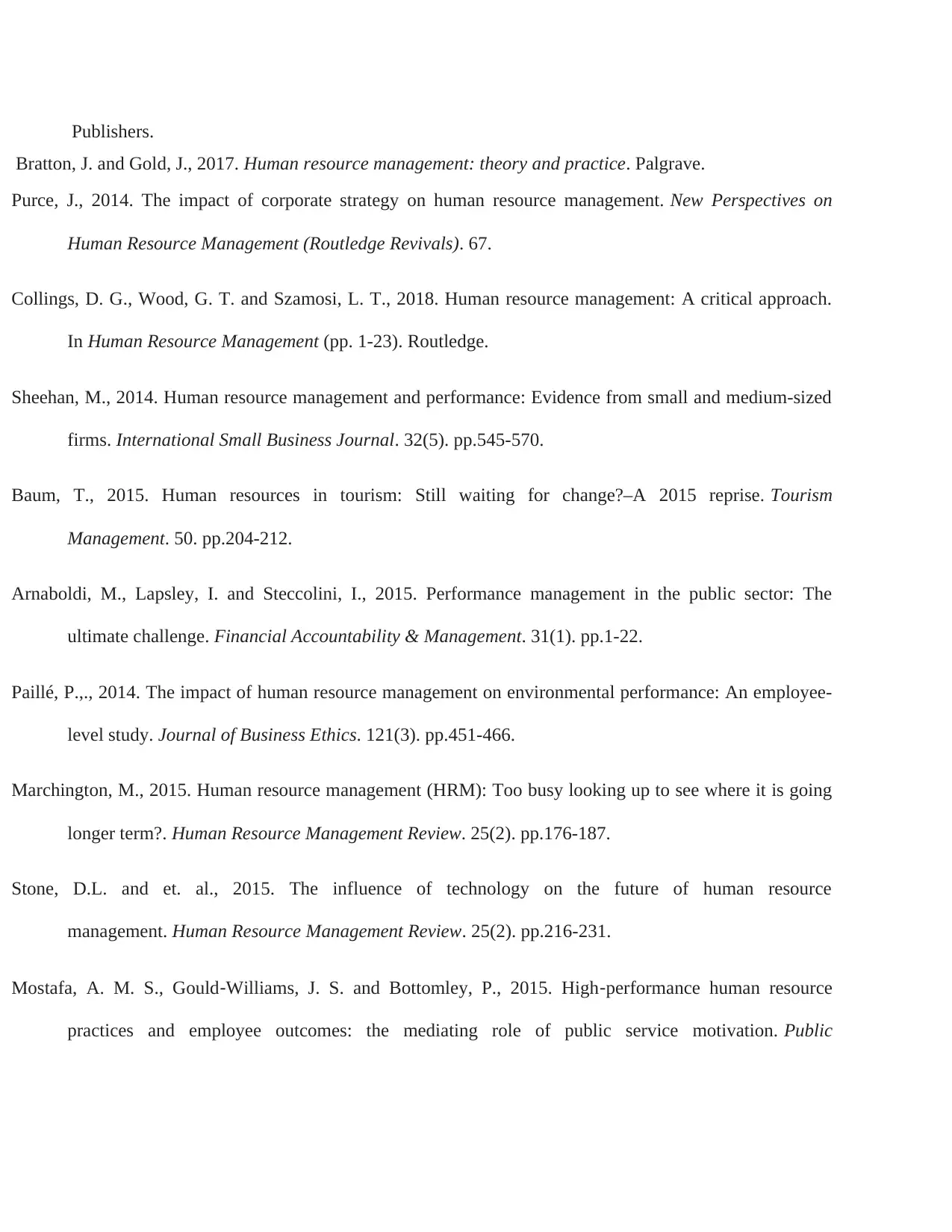
Publishers.
Bratton, J. and Gold, J., 2017. Human resource management: theory and practice. Palgrave.
Purce, J., 2014. The impact of corporate strategy on human resource management. New Perspectives on
Human Resource Management (Routledge Revivals). 67.
Collings, D. G., Wood, G. T. and Szamosi, L. T., 2018. Human resource management: A critical approach.
In Human Resource Management (pp. 1-23). Routledge.
Sheehan, M., 2014. Human resource management and performance: Evidence from small and medium-sized
firms. International Small Business Journal. 32(5). pp.545-570.
Baum, T., 2015. Human resources in tourism: Still waiting for change?–A 2015 reprise. Tourism
Management. 50. pp.204-212.
Arnaboldi, M., Lapsley, I. and Steccolini, I., 2015. Performance management in the public sector: The
ultimate challenge. Financial Accountability & Management. 31(1). pp.1-22.
Paillé, P.,., 2014. The impact of human resource management on environmental performance: An employee-
level study. Journal of Business Ethics. 121(3). pp.451-466.
Marchington, M., 2015. Human resource management (HRM): Too busy looking up to see where it is going
longer term?. Human Resource Management Review. 25(2). pp.176-187.
Stone, D.L. and et. al., 2015. The influence of technology on the future of human resource
management. Human Resource Management Review. 25(2). pp.216-231.
Mostafa, A. M. S., Gould‐Williams, J. S. and Bottomley, P., 2015. High‐performance human resource
practices and employee outcomes: the mediating role of public service motivation. Public
Bratton, J. and Gold, J., 2017. Human resource management: theory and practice. Palgrave.
Purce, J., 2014. The impact of corporate strategy on human resource management. New Perspectives on
Human Resource Management (Routledge Revivals). 67.
Collings, D. G., Wood, G. T. and Szamosi, L. T., 2018. Human resource management: A critical approach.
In Human Resource Management (pp. 1-23). Routledge.
Sheehan, M., 2014. Human resource management and performance: Evidence from small and medium-sized
firms. International Small Business Journal. 32(5). pp.545-570.
Baum, T., 2015. Human resources in tourism: Still waiting for change?–A 2015 reprise. Tourism
Management. 50. pp.204-212.
Arnaboldi, M., Lapsley, I. and Steccolini, I., 2015. Performance management in the public sector: The
ultimate challenge. Financial Accountability & Management. 31(1). pp.1-22.
Paillé, P.,., 2014. The impact of human resource management on environmental performance: An employee-
level study. Journal of Business Ethics. 121(3). pp.451-466.
Marchington, M., 2015. Human resource management (HRM): Too busy looking up to see where it is going
longer term?. Human Resource Management Review. 25(2). pp.176-187.
Stone, D.L. and et. al., 2015. The influence of technology on the future of human resource
management. Human Resource Management Review. 25(2). pp.216-231.
Mostafa, A. M. S., Gould‐Williams, J. S. and Bottomley, P., 2015. High‐performance human resource
practices and employee outcomes: the mediating role of public service motivation. Public
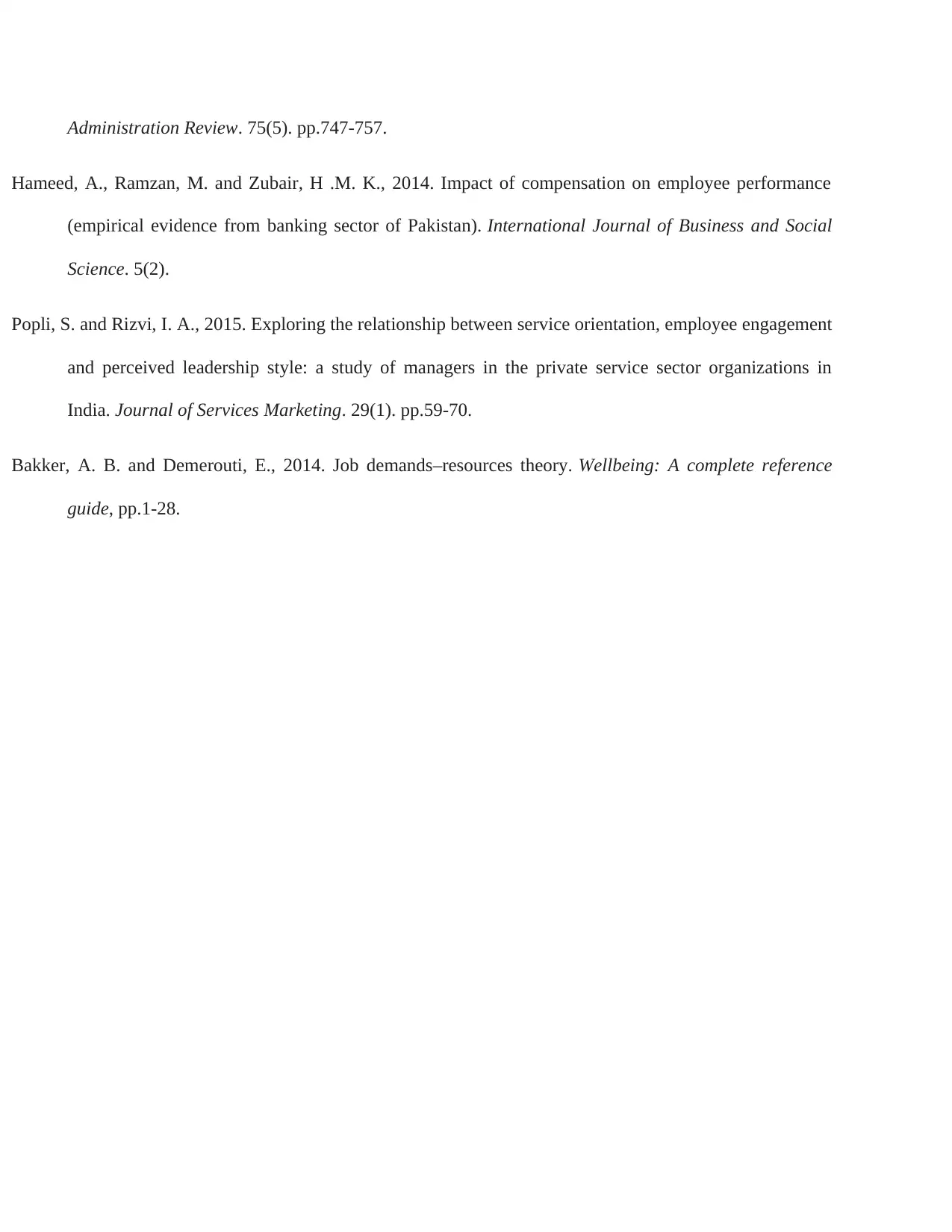
Administration Review. 75(5). pp.747-757.
Hameed, A., Ramzan, M. and Zubair, H .M. K., 2014. Impact of compensation on employee performance
(empirical evidence from banking sector of Pakistan). International Journal of Business and Social
Science. 5(2).
Popli, S. and Rizvi, I. A., 2015. Exploring the relationship between service orientation, employee engagement
and perceived leadership style: a study of managers in the private service sector organizations in
India. Journal of Services Marketing. 29(1). pp.59-70.
Bakker, A. B. and Demerouti, E., 2014. Job demands–resources theory. Wellbeing: A complete reference
guide, pp.1-28.
Hameed, A., Ramzan, M. and Zubair, H .M. K., 2014. Impact of compensation on employee performance
(empirical evidence from banking sector of Pakistan). International Journal of Business and Social
Science. 5(2).
Popli, S. and Rizvi, I. A., 2015. Exploring the relationship between service orientation, employee engagement
and perceived leadership style: a study of managers in the private service sector organizations in
India. Journal of Services Marketing. 29(1). pp.59-70.
Bakker, A. B. and Demerouti, E., 2014. Job demands–resources theory. Wellbeing: A complete reference
guide, pp.1-28.
1 out of 12
Related Documents
Your All-in-One AI-Powered Toolkit for Academic Success.
+13062052269
info@desklib.com
Available 24*7 on WhatsApp / Email
![[object Object]](/_next/static/media/star-bottom.7253800d.svg)
Unlock your academic potential
© 2024 | Zucol Services PVT LTD | All rights reserved.





